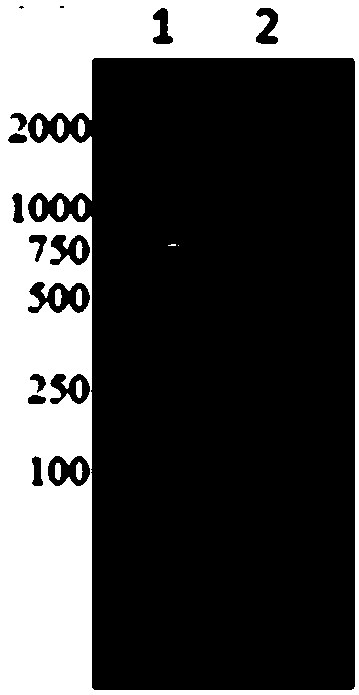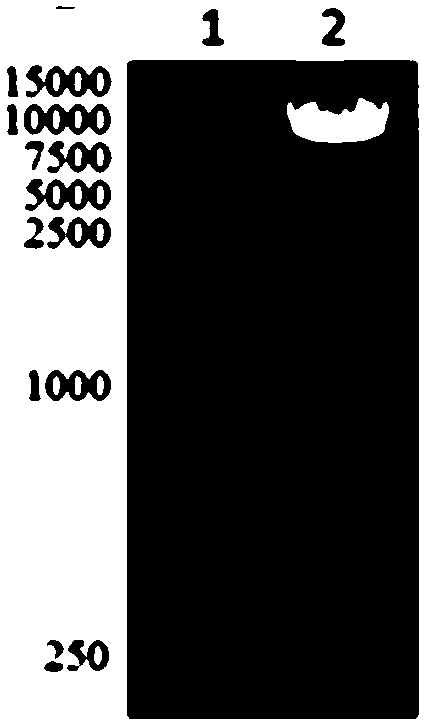FLT3 chimeric antigen receptor and application thereof
A chimeric antigen receptor and carrier technology, applied in the field of biomedicine, can solve the problems of poor expected therapeutic effect and prone to off-target effects.
- Summary
- Abstract
- Description
- Claims
- Application Information
AI Technical Summary
Problems solved by technology
Method used
Image
Examples
Embodiment 1
[0081] Example 1: Cloning of antigen recognition region FLT3 ligand (FLT3L) in chimeric antigen receptor
[0082] 1. Extract the total RNA of the patient's bone marrow mononuclear cells: at 5×10 6 Add 1ml of RNA iso Plus (Takara) to the cells, and mix well by pipetting. Add 200 μl of chloroform, invert up and down, and vortex to mix. Centrifuge at 12000 rpm for 5 minutes at 4°C. Pipette the supernatant into a 1.5ml EP tube, add the same volume of isopropanol, and mix by gently inverting up and down. Centrifuge at 12000 rpm for 15 minutes at 4°C. Pre-cool 75% ethanol to precipitate RNA at 4°C, and dissolve total RNA in 50 μl DEPC water.
[0083] 2. Synthesize the first strand of cDNA by reverse transcription: Prepare the PCR reaction system (20 μl) as follows: Oligo d(T)15Primers: 2 μl; M-MLV (200u / μl): 1 μl; dNTP (each 2.5mM): 1 μl; DTT ( 0.1M): 2μl; First strand buffer (5×): 4μl; CD20-RNA: 2μg; DEPC water: make up to 20μl. Reaction conditions: 37°C, 60 minutes, 70°C, 10...
Embodiment 2
[0088] Example 2: Construction of Chimeric Antigen Receptor Vector
[0089] 1. Digest the plasmid containing the CD8α-4-1BB-CD3ζ fragment with Nhe I and EcoR I endonucleases to obtain the CD8α-4-1BB-CD3ζ fragment, the amino acid sequence of which is shown in SEQ ID NO.5. The plasmid containing the CD8α-4-1BB-CD3ζ fragment can be prepared by any suitable method in the prior art.
[0090]2. Ligate the FLT3L fragment obtained in Example 1 with the destination vector, and construct the FLT3L-CD8α-4-1BB-CD3ζCAR destination vector. NheI and NotI were used for enzyme digestion identification. The result is as figure 2 As shown, the enzyme digestion results showed that the positive clone contained the target band and was correctly identified by sequencing. The schematic diagram of the carrier is as image 3 shown.
Embodiment 3
[0091] Example 3: Preparation of Chimeric Antigen Receptor FLT3L-CD8α-4-1BB-CD3ζ Lentiviral Modified T Cells
[0092] 1. Use EndoFree Plasmid Maxi Plasmid Extraction Kit (QIAGEN Company) to extract FLT3L-CD8α-4-1BB-CD3ζ expression plasmid and packaging plasmid psPAX2, PMD.2G. The three plasmids were transfected with Turbofect Transfection Reagent (Thermo Company) at a ratio of 4:3:1 (see the manual of Turbofect Transfection Reagent for specific methods). The virus supernatant was collected 24 hours and 48 hours after transfection, centrifuged at 4°C, 3000rpm for 10 minutes, filtered through a 0.45μm filter, concentrated 10 times by ultracentrifugation at 50000g, 4°C for 3 hours, and then transferred to - Store at 80°C.
[0093] 2. Preparation of T cells: Take 10 ml of fresh healthy human peripheral blood, and use RosetteSep T cell enrichment Cocktail (Stemcell) and Ficoll-Paque PLUS (GE Healthcare) to extract T cells (specific steps follow RosetteSep T cell enrichment Cocktai...
PUM
 Login to View More
Login to View More Abstract
Description
Claims
Application Information
 Login to View More
Login to View More - Generate Ideas
- Intellectual Property
- Life Sciences
- Materials
- Tech Scout
- Unparalleled Data Quality
- Higher Quality Content
- 60% Fewer Hallucinations
Browse by: Latest US Patents, China's latest patents, Technical Efficacy Thesaurus, Application Domain, Technology Topic, Popular Technical Reports.
© 2025 PatSnap. All rights reserved.Legal|Privacy policy|Modern Slavery Act Transparency Statement|Sitemap|About US| Contact US: help@patsnap.com



